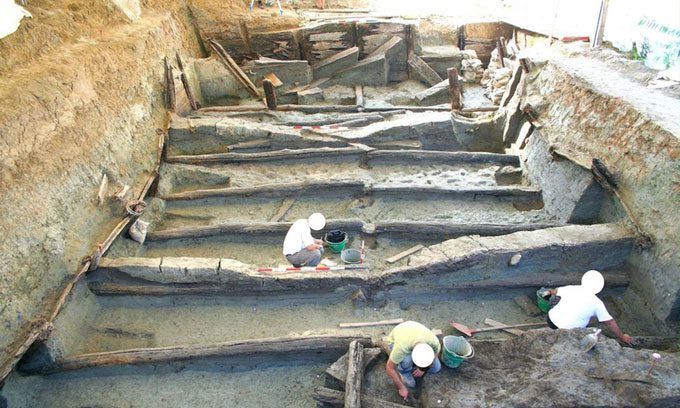The ancient water basin measures over 12 meters long, built with great care and likely used for sacred rituals.
Scientists have dated the oak-planked water basin, which is approximately 12.2 meters long, 7 meters wide, and 4 meters deep, located on a hill in the Po Valley, northern Italy, Smithsonian reported on July 13. The new study was published in the journal PLOS One.

The Noceto Vasca Votiva water basin dates back approximately 3,400 years. (Photo: Ministry of Culture, Italy).
The basin was first discovered in 2004 and named Noceto Vasca Votiva. The basin’s interior features a structure that appears to have collapsed before completion, with a second structure built on top. Sediments within the basin indicate it was once filled with water. Based on its location and the large amount of wood required for its construction, scientists believe that building it was a labor-intensive process.
By combining carbon dating techniques with tree-ring analysis, the research team determined that the lower layer of the water basin was built in 1444 BC, while the upper layer was constructed in 1432 BC, with an error margin of only about four years. In addition to dating, the research team discovered that the basin was used for several decades before being abandoned for unclear reasons.
New analysis results indicate that the Noceto Vasca Votiva was constructed during a time of significant societal change. The Terramare culture in this area became more complex around the mid-15th century BC. Small farms evolved into larger settlements, and people increasingly adopted plowing and irrigation techniques to boost agricultural productivity.
There is substantial evidence suggesting that Noceto Vasca Votiva served sacred purposes, according to co-author Sturt Manning, an archaeologist at Cornell University. The location of the basin is impractical for providing water to the local populace. Additionally, there are no surrounding water channels, indicating it was not intended for irrigation. Instead, the elaborate construction process and the discovery of small statues and ceremonial vessels within the basin suggest it was used for spiritual purposes.
Ancient peoples often created complex and labor-intensive ceremonial structures during a time when new economic and social frameworks were emerging, according to Manning. Water-related ceremonial structures dating back to the 15th century BC have been discovered in various locations, such as Crete (Greece). However, Noceto Vasca Votiva is the only structure of its kind found in northern Europe.
The sacred purpose of Noceto Vasca Votiva may relate to the importance of water in the Po Valley, where inhabitants developed intricate systems of levees and terraces for irrigation. Although the basin does not belong to this irrigation system, ancient peoples may have used it to invoke the gods responsible for water and rainfall.





















































